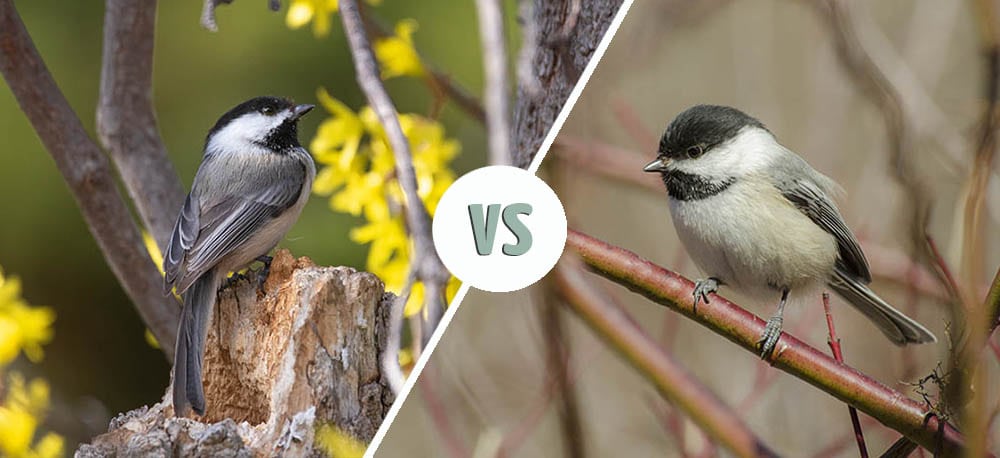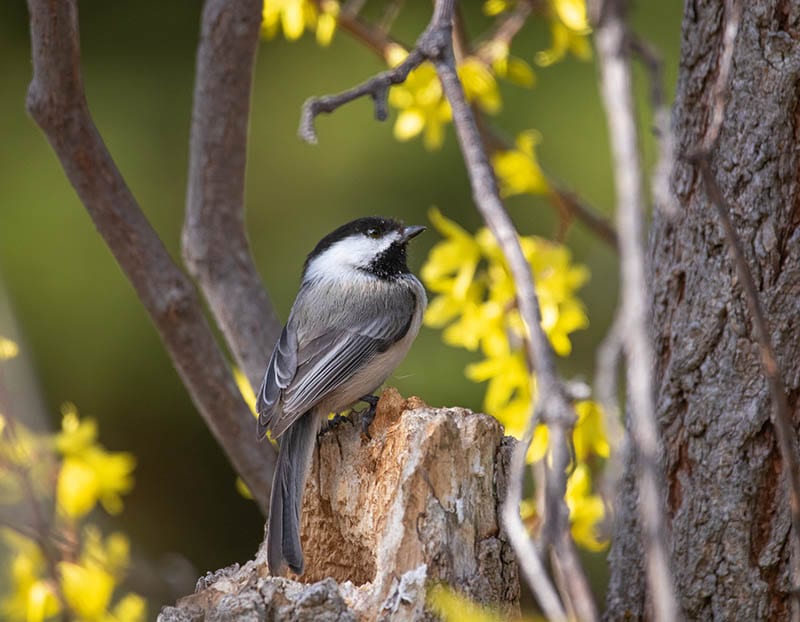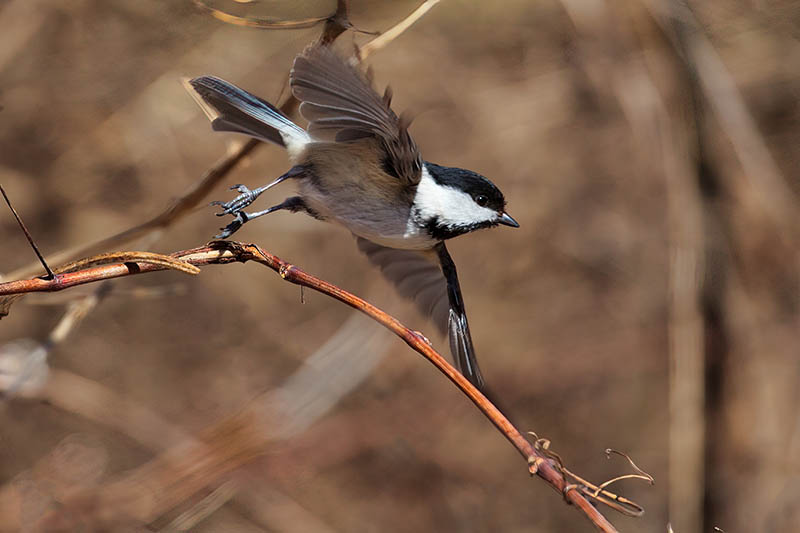Male vs. Female Black-Capped Chickadees: How to Tell the Difference
Last Updated on

Have you ever seen small birds flying in the sky with gray, white, black, and sometimes buff plumage? These Black-capped Chickadees are incredibly cheerful and often found gracing the bird feeders and woodlands across the entire north of America. Some of these chickadees are male, while others are female, and if you are interested in the world of birds, you may want to differentiate between the two.
In this discourse, let’s explore how both genders vary. Also, let’s find out some interesting facts about Black-capped Chickadees.

Visual Differences

At a Glance
- Average height: 4–6 inches
- Average weight: 11–12 grams
- Average height: 4–6 inches
- Average weight: 11–12 grams
Black-Capped Chickadees 101
The Black-capped Chickadee is a recognizable and famous bird in North America. This songbird is similar to the Carolina Chickadee but can be differentiated through white markings on the wings.
These birds are pretty tiny and usually weigh less than an ounce. Most adult birds are just six inches long and have a wingspan of 6–8 inches. Black-capped Chickadees have a striking color pattern with a black neck and head. They have a black back, tail, and wings with loud and striking white and black markings. The belly is entirely white with dark-brown patches close to its wings.
These beautiful birds love to travel together in flocks and use their calls to signal other birds of any danger and food. Chickadees have a unique call that goes like, chickadee-dee-dee-dee. That’s how the bird got its name.
Black-capped Chickadees are usually found in North America. Their range stretches from north of Alaska to Canada. They can also be traced to the west of California, New Mexico, and the east side of New York. These birds don’t like to migrate, so you can observe them in these areas throughout the year.
Another distinct quality of this bird is that it is pretty social. It is a communicative bird and helps each other stay away from predators. Whenever a bird spots a threat, it makes its warning call and prepares the rest of the members to stay alert. Since they like to stay in groups, these birds also usually eat together. Their diet includes insects, pests, insect eggs, and seeds to keep them full for long.
The lifespan of chickadees is usually around 3 years in the wild. However, the oldest Chickadee has lived for almost 11.5 years.
Male Black-Capped Chickadee Overview
A male Black-capped Chickadee may look similar to its female version, but there are many apparent differences.

Personality
Male Black-capped Chickadees have a vibrant personality and are often helpful to their partners. It likes to protect its nesting territory. It does so by singing a short song repeatedly to keep other birds away. The song of the male Chickadee often sounds like “fee-bee-bee.” The first note is always higher than the last note. Most male Black-capped Chickadees also like to feed their partners. This often exhibits their love and interest in each other.
Training
The male Black-capped Chickadees can be trained and fed by hand. This is because these birds are quite intelligent.
They also have a very sharp memory that allows them to remember the exact location where they have kept their food. But unfortunately, in many places, it is illegal to keep the bird as a pet.
Health & Care
Black-capped Chickadees often suffer from Avian Keratin Disorder, an emerging disease among many small birds in North America. This disease results in deformities and overgrowth of the beak. The first case was observed in 1990. Since then, things have spread quite rapidly.
Male Black-capped Chickadees also usually die after predator attacks. The Northern Shrike and hawks are the most prominent predators of these birds.

Breeding
During the breeding season, the male feeds the female bird when she begs for food. They also select a nesting site together, and then the female lays its eggs to incubate them. The male Black-capped Chickadee is pretty calm during the breeding season and keeps other birds away as much as possible.
- Calm birds that support their partners
- Can consume plant-eating pests
- Can’t be kept as pets
- Can catch disorders that might defect their beaks

Female Black-capped Chickadee Breed Overview
A female Black-capped Chickadee has many excellent and unique characteristics that make it different from its male partner. Below we have summarized a few.

Personality
Female Chickadees are slightly bigger than males. The female Black-capped Chickadee is quite similar to its male version but has smaller bibs that differentiate it from its partner. Also, when it comes to the bird’s personality, the female Black-capped Chickadee is a lot calmer than its partner.
A female Black-capped Chickadee often calls her partner with a unique “chick-a-dee-dee-dee” sound and requests it to feed her during nesting. The female bird builds the entire nest while the male bird protects it from predators.
Training
Just like male Black-capped Chickadees, female birds are also pretty smart. This means that they can be tamed easily. However, it isn’t permitted to keep one as a pet.
All Black-capped Chickadees use the method of caching. They use a thoughtful approach to keep their food safe. Both female and male birds hide their food in different crevices and barks and then use their sharp memories to locate them.
Health & Care
Adult female Black-capped Chickadees often lose their lives while nesting. This usually happens due to weasels. Weasels are mammals that are small carnivores and have slender bodies.
Most female Black-capped Chickadees are often victims of the Avian Keratin Disorder, spreading rapidly in their native land. This affects their beaks and deforms them for an extended time.

Breeding
For breeding, the female Chickadee builds the nest using feathers, grasses, mosses, and hair. The bird often evacuates a place or takes over a cavity to construct a unique cup-shaped nest. When nesting, the bird calls for food, and the male partner feeds it to keep it healthy.
Within three days of building a nest, the female bird lays the eggs, usually between April and July. It takes about 12–13 days for the nest to be complete with six to eight eggs.
- Builds a nest on its own
- Smart and intelligent breed
- Can’t be kept at home
- Often consumed by weasels

Which Gender Is Right for You?
If you are a bird lover, male and female Black-capped Chickadees may appeal to you. They are similar physically, but females seem more responsible and caring regarding nesting. On the other hand, male Black-capped Chickadees are protective and pretty lively.
These birds are usually found in North America. If you are around, you may spot one. To distinguish, just remember that male birds are smaller than their female versions and have large bibs.
Featured Image Credit: (L) Annette Shaff, Shutterstock | (R) elinorb, Shutterstock
About the Author Jeff Weishaupt
Jeff is a tech professional by day, writer, and amateur photographer by night. He's had the privilege of leading software teams for startups to the Fortune 100 over the past two decades. He currently works in the data privacy space. Jeff's amateur photography interests started in 2008 when he got his first DSLR camera, the Canon Rebel. Since then, he's taken tens of thousands of photos. His favorite handheld camera these days is his Google Pixel 6 XL. He loves taking photos of nature and his kids. In 2016, he bought his first drone, the Mavic Pro. Taking photos from the air is an amazing perspective, and he loves to take his drone while traveling.
Related Articles:
Holy Stone Drone Review of 2024 – Pros, Cons, and Verdict
Ultraviolet Light vs Black Light: What’s the Difference?
Light Waves vs. Sound Waves: The Key Differences
Infrared vs. Thermal Cameras: How Are They Different?
Far Infrared vs Near Infrared: What’s The Difference?
Mottled Duck vs. Mallard vs. Black Duck: What’s the Difference?
Shutter Speed vs Frame Rate: Pros, Cons, & Difference
Oriole vs Goldfinch: How to Tell the Difference
